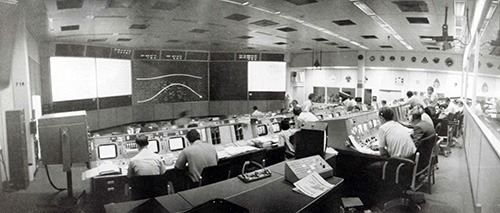|
The Houston Mission Control emblem developed by space artist Bob McCall. Image: Hamish Lindsay. Reproduced courtesy of Gene Kranz. |
The Mission Control Center, Houston
by Hamish Lindsay
with Gene Kranz, Apollo Flight Director
|
The Houston Mission Control emblem developed by space artist Bob McCall. Image: Hamish Lindsay. Reproduced courtesy of Gene Kranz. |
 |
|
The Mission Operations Control Room during the Apollo 15 lunar landing. Scan: Hamish Lindsay. Click on the image for a larger version. |
At the heart of the manned space flight missions was the Mission Control
Center HOUSTON (MCC-H) in the Mission Operations Wing of Building 30.
Inside the windowless building were two Mission Operations Control Rooms (MOCR) on floors two and three. The second floor MOCR was used for three Apollo Saturn 1B Missions, and Apollo 5-7 and 9, Skylab and Apollo-Soyuz missions. The third floor MOCR was used for all the Gemini and Apollo lunar missions. Outside the control room but on the same floor were all the Staff Support Rooms (SSRs) housing the technical specialists responsible for supporting their counterparts in the MOCR.
The first floor of Building 30 was the Real Time
Computer Complex (RTCC). The tracking stations interfaced with the MOCRs through
the Communications, Command and Telemetry System (CCATS) on the first floor.
|
A plan of the 3rd floor of the Mission Operations Wing of Building 30. Scan: Tom Sheehan. Click on the image for a larger version. |
The Mission Operations Control Room (MOCR),
was the principal command and decision area for each mission, and was the
“Houston” frequently referred to. The centre of a complex world-wide
communications network to tracking stations, ships and aircraft, it had 19
main areas of responsibilities shown in the diagram below.
 |
|
Click on the image for a much larger version. |
|
Backing the above front line operators in the MOCR were 7 Staff Support Rooms (SSR): |
The Mission Control emblem
During Apollo 17 Gene Kranz was feeling frustrated and despondent – it was the last Apollo Mission, the end of an era. He met space artist Bob McCall in the cafeteria over a cup of coffee, and suggested they produce an emblem, like the Apollo missions, for the Control Center. Kranz wrote, “I spoke emotionally, from my heart and gut, about the control teams and crews, and our life in Mission Control.”
Over the next six months McCall developed the emblem and inscribed his final rendering with, “To Mission Control, with great respect and admiration, Bob McCall, 1973.”
Sigma was chosen as the dominant element, representing the total mission team. In addition it represents the individual flight control teams from all programs past, present and future. Within the teams it represents all engineering, scientific and operations disciplines in support of the spacecraft.
The rocket launch represents the dynamic elements of space and the initial escape from our environment and the thrust to explore the Universe.
The remaining elements are the Earth, planets and the stars. The Earth is our home and will forever be serviced by both manned and unmanned spacecraft in order to improve the quality of our present home. The stars and planets represent a major source of study as well as the challenge of exploration for future mission control teams.
The border contains symbols to represent the Mercury, Gemini and Apollo Programs, the three major programs that have been supported by the team. The four stars represent the present and future programs: Skylab, Apollo-Soyuz, Earth Resources and the Shuttle.
The wording was chosen to stress the very positive attitude used by the Mission Control team to assure crew safety and mission success.
“Achievement through Excellence” is the standard for the flight controllers’ work. It represents an individual’s committment to a belief, to craftsmanship and perseverance.
(The Mission Control emblem is used with the kind permission of Gene Kranz.)